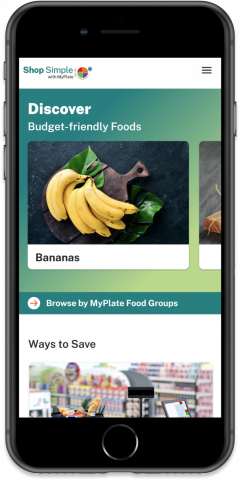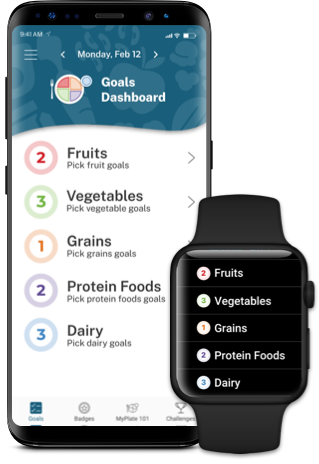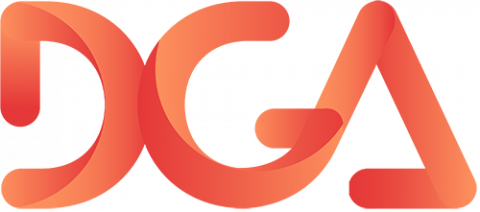Dairy
Move to low-fat or fat-free dairy milk or yogurt (or lactose-free dairy or fortified soy versions).
What foods are included in the Dairy Group?
The Dairy Group includes milk, yogurt, cheese, lactose-free milk and fortified soy milk and yogurt.
The Dairy Group does not include foods made from milk that have little calcium and a high fat content. Examples of this are cream cheese, sour cream, cream, and butter.
More About the Dairy Group
The table below lists specific amounts that count as 1 cup in the Dairy Group towards the daily recommended amount.
Note: Click on the top row to expand the table. If you are on a mobile device, you may need to turn it sideways to see the full table.
*These are general recommendations by age. Find the right amount for you by getting your MyPlate Plan.
| Daily Recommendation* | ||
|---|---|---|
| Toddlers | 12 to 23 months | 1⅔ to 2 cups |
| Children | 2-3 yrs | 2 to 2½ cups |
| 4-8 yrs | 2½ cups | |
| Girls | 9-13 yrs | 3 cups |
| 14-18 yrs | 3 cups | |
| Boys | 9-13 yrs | 3 cups |
| 14-18 yrs | 3 cups | |
| Women | 19-30 yrs | 3 cups |
| 31-59 yrs | 3 cups | |
| 60+ yrs | 3 cups | |
| Men | 19-30 yrs | 3 cups |
| 31-59 yrs | 3 cups | |
| 60+ yrs | 3 cups | |
| Amount That Counts as 1 Cup in the Dairy Group | |
|---|---|
| Milk |
1 cup milk 1 half-pint container milk ½ cup evaporated milk 1 cup calcium-fortified soy milk 1 half-pint container calcium-fortified soy milk |
| Yogurt | 1 cup yogurt (dairy or fortified soy) |
| Cheese |
1 ½ ounces hard cheese (cheddar, mozzarella, Swiss, Parmesan) ⅓ cup shredded cheese 1 ounce processed cheese (American) ½ cup ricotta cheese 2 cups cottage cheese 2 ounces queso fresco 2 slices queso blanco |
Why is it important to eat or drink dairy?
Eating or drinking dairy products offers health benefits, like building and maintaining strong bones. Dairy Group foods provide nutrients that are vital for the health and maintenance of the body. These nutrients include calcium, potassium, vitamin D, and protein.

Health Benefits
All food and beverage choices matter. Focus on variety, amount, and nutrition.
Calcium and vitamin D are important nutrients at any age. Eating or drinking dairy products that have these nutrients help to:
- Improve bone health, especially in children and adolescents when bone mass is being built.
- Promote bone health and prevent the start of osteoporosis in adults.
For those who choose not to eat or drink dairy products

Fortified soy milk and yogurt with added calcium, vitamin A, and vitamin D are a part of the Dairy Group. This is because their nutrition content is like dairy milk and yogurt.
Other products sold as “milks” but made from plants like almond, rice, coconut, oat, and hemp “milks” may have calcium. But, they are not a part of the Dairy Group because their nutrition content is not like dairy milk and fortified soy milk.
There are calcium choices for those who do not eat or drink dairy products. However, these are not part of the Dairy Group.
The amount of calcium your body can absorb (or take in) from these foods may vary.
- Calcium-fortified juices
- Calcium-fortified plant-based milk alternatives, such as rice milk or almond milk
- Canned fish, such as sardines and salmon with bones
- Tofu made with calcium sulfate
- Tahini, such as sesame butter or paste
- Some leafy greens, such as collard and turnip greens, spinach, kale, and bok choy
For more information, see the Dietary Guidelines for Americans, 2020-2025: Food Sources of Calcium.
Food Group Gallery
Do you want to know more about the foods in the Dairy Group? What does a cup of dairy look like? Check out the Food Group Gallery! This is also a great resource if you're trying to move to fat-free or low-fat dairy. It will also help if you want to try something new. This is also a great resource if you're trying to move to fat-free or low-fat dairy. It will also help if you want to try something new.
Soy milk, lactose-free milks, queso blanco... they are waiting for you in the Food Group Gallery.






